Duke
We were fortunate enough to be able to acquire a Desert Tortoise. Garrett's past Kindergarten teacher (Thank you Kristi!) was kind enough to gift¹ us a hatchling. It² was hatched in October of 2005. Garrett gave it the name of "Duke". He obtained this name from a character in a book he enjoyed reading.
Since Duke is too young to stay outside, for safety and other reasons, we currently have him in a temperature controlled, 75-85 degrees, 20 gallon aquarium, measuring about 12"x30". Duke has a UVB light to produce the needed sunlight to insure its shell grows and is strong. Duke's cage is lined with a newspaper base, with some shredded newspaper for burrowing (which he loves to do!) and a tunnel for more shelter. In a few more years we will have an area outside for Duke to reside in. Right now, Duke goes outside for sun and play with us.
Duke is fed a few times a day. Most (75%) of Duke's diet consists of leafy greens (dandelion, endive, collards). He also gets some vegetables (broccoli, his favorite, carrots, peas) and fruits (mangos, grapes, apples)
Normally the Desert Tortoise will hibernate from October until about March or April. But, it is recommended for the first couple of years not to allow them to hibernate due to not having enough fat stored up. To prevent hibernating you just need to keep the temperature up, 75+ degrees, and allow exercise and eating. He still seems to sleep through the night and frequent naps during the days.
top
Desert Tortoise - October 2006
Update: Duke's ONE now. He's doing great and has about doubled in size since we obtained him last year, as a hatchling. He still eats the same type of foods and still a few times a day, but in bigger quantities. He still prefers us to chop up his food. Well, he seems to eat more when we do. We've had to upgrade some of his surroundings, a bigger water bowl, larger tunnel etc. due to him being bigger now.
We're thinking this will be his last year to not hibernate, and then building him an enclosure outside for the spring and beyond.
Desert Tortoise - October 2008
Update: Three years old now. He hibernated last year, inside our house, in his aquarium without a heater. It was November when we brought him in. The evenings were getting much colder (under 50 degrees) so we thought it would be a good time. He started sleeping for one or two days for about a week and then he kept adding days to his sleeping schedule. It then turned into a weekly sleep, and then by early December he was out until March. During his brief wakings I would have food available for him. He was eating maybe 25-50% of his normal intake but it seemed that is why he was up and about. He would eat for an hour or so, and then back to sleep. We will provide the same environment for him for this winter's hibernation.
Desert Tortoise - May 2011
Update: Duke began hibernation around Thanksgiving time last year. He came out only a couple of times to grab a quick bite to eat and then was out for quite a while. He still stays indoors in the aquarium, filled with dirt, with a upside-down shoebox with a doorway made of newspaper. I do this so he has a dark place to hang out in. Duke hibernated a bit longer than normal. I believe this was due to cooler weather this year in San Diego lasting through May. He was his normal sluggish self for a week or so eating about half portions. Then later in the month he began to eat normally. Normally, now seems to be a pile of greens the size of him about each day, or sometimes every other day.
Desert Tortoise - May 2013
Update: It looks like Duke is a male. Checking his underside this spring he has the concave bottom now. Duke began hibernation around Thanksgiving this past year again. He pretty much went straight into hibernation. He is still hibernating indoors, in an aquarium as described previously. Duke hibernated all the way to the end of April. It was a cooler spring again, which I believe made his hibernation longer. Again, he was his normal sluggish self for a week or so eating about half portions. Then, resumed to eating a pile of greens about the size of him.
topAnnual Pictures
.jpg) |
.jpg) |
| You can see he isn't all that big. His shell measures about two inches long by 1-1/2 inches wide. | |
.jpg) |
.jpg) |
| Out for some sunning in the backyard. | |
 |
.jpg) |
| When sleeping he often just sprawls out. | Breakfast time, with a
chopped up mixture of endive, dandelion, and collards |
.jpg) |
.jpg) |
| In action, at breakfast. | Garrett watching Duke eat. |
|
March 2006, 4 Months Old |
|
 |
 |
| March 2006, 4 months later,
it looks like he's grown at least 1/2 inch in length. |
And some more sunning and exercise in the backyard |
|
October 2006, 1 Year Old |
|
 |
 |
| October 2006, 1 Year Old!
Duke's doubled in size since a hatchling. He's about 4 inches long and 3 inches wide now |
1 year old and still checking out our back yard. |
|
April 2007 |
|
|
|
|
| During spring break 2007 Garrett and I built a new outdoor enclosure for Duke |
Duke in his new enclosure.
For now, he will use this during the warmer months |
|
October 2007, 2 Years Old |
|
 |
 |
| October 2007, 2 Years Old! He's about 5 inches long and 4 inches wide now. He's pretty dirty lately because he gets to stay outside in his enclosure for the summer, and loves to dig. He enjoys coming out in the morning for some sunning and then breakfast and then hangs out for the day. | 2 years old, dirty, and checking out our back yard. We'll let Duke try out hibernating this year. We filled his aquarium half way with dirt and will place a shoebox upside down with an opening in the hopes he'll find a nice spot to dig and rest for a few months once it gets cooler |
|
October 2008, 3 Years Old |
|
 |
 |
| October 2008, 3 Years Old He's about 6 inches long and about to 4-1/2 inches wide now. His daily routine consists of eating first thing in the morning, for a few hours, I think. Then hanging out, roaming around, and eating a bit more. If he's not awake yet in the morning at feeding time, he wakes up when he hears me opening up his enclosure and comes pretty quick over to the food. He eats quite a bit now too. I give him a pile of greens about the size of him. Almost daily he eats it all. He really seems to enjoy his watering hole too. He seems to go through it daily. His watering hole gets filled automatically daily. | As normal, sometimes we bring him out in the yard for some free time exploring. We're still waiting for him to be big enough to always leave him in the back yard. With how small he is, we're still a bit worried some sort of predator may get him. So always leaving him in the back yard without supervision may be another year or so away. |
|
October 2009, 4 Years Old |
|
 |
 |
| October 2009, 4 Years Old He's almost 7 inches long and about to 5-1/2 inches wide now. His routine is still the same - waking up in the morning for some sun and feeding, and then cruising around a bit. He still enjoys going in his wading pool. I mention this again because I think it is a strange trait for a desert tortoise. Maybe it is the norm though. I don't know. I give him a pile of greens daily, still piling it about as big as he is, and he consumes it daily. | Another day with some time in the yard. We still don't leave him out alone for the fear of something happening to him. He does seem to enjoy checking the different things in the yard. About one more month and he'll be ready to hibernate again. We bring him inside for the winter in an aquarium filled with dirt and a turned over shoebox with an opening for him to go in and out. Last year he hibernated from about Thanksgiving until April. For the first few weeks he would come out once and awhile to snack on some food for an hour and then goes back to sleep. After that, he was out. I would check on him later inthe hibernation months, February and beyond, to make sure he was okay, by just touching his foot to get a little movement. |
|
October 2010, 5 Years Old |
|
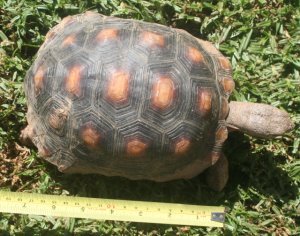 |
 |
| October 2010, 5 Years Old He's over 7 inches long now and about 6 inches wide. Getting taller too, but I don't measure that.Nothing new going on for Duke. Still wades in the pool daily, does his sunning, and eats his greens. He was pretty active trying to take pictures this year. I had to go along with him while he was exploring, so not the best measurements. | He still spends most of his time in his enclosure. This is because I'm still nervous about leaving him out in the open. Hopefully, I'll get over that soon and will be able to leave him out in the open yard. We just put him in his indoor aquarium for hibernating for the winter, Nov. 20. It stayed warmer a bit longer this year, but the days are still shorter and he was becoming a bit more sluggish and not eating as much the past week. As soon as we placed him in his indoor aquarium he began to dig. We still leave him food daily if he decides to come out for a snack for the new few weeks. Then, it is a good sleep until about March or so. |
|
October 2011, 6 Years Old |
|
 |
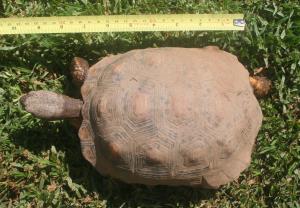 |
| Not a lot of growth from last year. Under 8 inches long and 6 wide. He was still very active while trying to measure him. While he was walking I was moving the tape measure. Not the most accurate but gives an idea. Still wades in the pool multiple times daily, does his sunning, and eats his greens. | He still spends most of his time in his enclosure. I'm still not comfortable leaving him outside on his own. |
|
October 2012, 7 Years Old |
|
 |
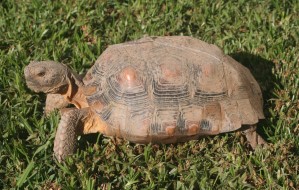 |
| A bit over 8 inches long and about 6 inches wide. Always tough getting good measurements when he's walking around though. His favorite greens seem to change year by year. Last year it was dandelions and this year it seems to be endive. A normal hibernation time, for Duke, goes inside mid November and out about March. | I'm still unable to leave him unattended outside of his enclosure. Maybe next year I'll let him out longer. |
|
October 2013, 8 Years Old |
|
 |
 |
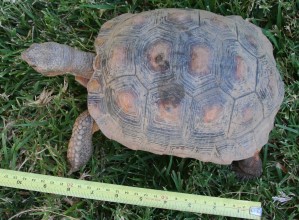 |
 |
| About 8-1/2 inches long by 6-1/2 inches wide. He was very active today but my son Garrett assisted with pictures so that made it easier. Still eating a variety of foods. This year he still seems to favorite endive, and then really likes different fruits - grapes, apples, etc. | Duke continues to use his wading pool daily to cool down (I'm guessing). I'm still not comfortable leaving him unattended outside of his enclosure. I hope too soon. |
|
|
|
|
October 2014, 9 Years Old |
|
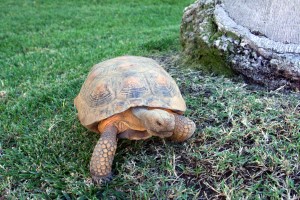 |
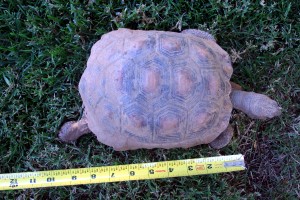 |
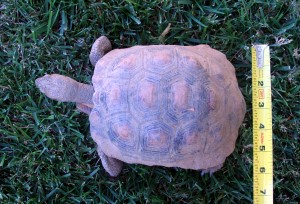 |
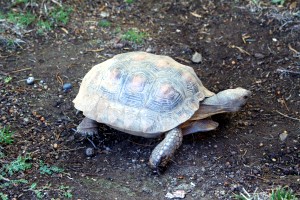 |
| His measurements are really close to last year's. It is hard to tell how much he's grown. Visually, he seems larger all around and heavier, but it is too hard to tell with the measurements I have. I did try out some different food from a place in Arizona, but Duke didn't care for that at all. So, still with the same diet.Still eating a variety of foods. | Duke still does his wading multiple times a day, and is still mostly in his enclosure. I take him out and let him roam around the front yard, supervised. |
|
October 2015, 10 Years Old |
|
|
|
|
|
|
|
| I was able to get better measurements this year. It was a cooler day, and then I let him roam around until he tired out and was resting. He is just short of 9 inches in length, and 7 inches in width. | Still doing supervised outings in the yard. His favorite food, besides the different tasty fruits here and there that he devours, are dandelions. |
|
October 2016, 11 Years Old |
|
|
|
|
|
|
|
| After tortoise proofing the back yard, I finally decided to allow Duke to roam free in the entire back yard. I built him a new enclosure, allowing him to come and go as he pleases. The enclosure is filled with dirt, and then food and water available outside his entrance. He seemed to adapted to his new enclosure quickly, going up and down the ramp whenver and returning for the night to sleep. | The top photo is Duke warming in the sun. I bothered him a bit by taking pictures, but it is interesting, to me, when he spreads all his limbs out, I'm guessing to get the most out of the sun. Our dog, Keeha, pretty much ignores Duke, as she's seen him in the enclosure all these years. By measurements, Duke seems about the same size, but by looking or lifting he seems bigger. It is hard to get good measurements. This year, I tried while he was sunning. |
|
October 2017, 12 Years Old |
|
|
|
|
|
|
|
| A successful year roaming free in our back yard. It took a couple weeks to remind Duke where "his" shelter and eating area was. He would sometimes spend the night in the side yard, without any shelter, and I would place him back prior to me going to bed. Overall, a good decision, so far, to have him roaming free. At least I feel better about it! | I think I've learned - wait until it is cooler out, and Duke suns to warm up and stays put longer for photos. Duke appears to have grown a bit, both in length and width. About 9 inches in length (maybe a tad more), and 7-1/2 in width. For treats, Duke absolutely loves eating the hibiscus flowers. Normally on the weekend I'll sit with him and feed him 3 or 4 flowers. |
|
October 2018, 13 Years Old |
|
|
|
|
|
|
|
| Another successful year and nothing too much different. Duke did stay out one night during a random, seldom, heavy rain in the San Diego area. This cleaned his shell, so looking a bit cleaner for this years pictures. | As always, a bit hard to read the measurements.
He's about 9-1/2+ inches in length and about 8 inches wide. For treats, Duke still absolutely loves eating the hibiscus flowers. |
|
October 2019, 14 Years Old |
|
|
|
|
| Another successful year and nothing too much different. Better, or normal weather this year, so plenty of sun. Sunning next to step to gather as much warmth as possible. Tends to like to sun until it warms up into the 70's or so then it is feeding time. | No noticable growth from last year, as he may have reached full size. He's still about 9-1/2+ inches in length and about 8 inches wide. Sticking with the same sort of diet, mainly endive and dandelion an some hibiscus flowers for treats. And, different sorts of fruits once or so a week. |
 |
|
| Duke's F&G registration (with some numbers removed from the image)) | |
Footnotes
¹Desert tortoises are protected both at federal and state levels. As a consequence of this, it is illegal to collect desert tortoises from the wild without a permit from both the federal government and the states of California, Nevada, Utah or Arizona. It is illegal to buy or sell desert tortoises, regardless of their point of origin. The only legal way for the average individual to acquire a desert tortoise is to adopt one from a State Game and Fish sanctioned organization or to receive a captive born hatchling as a gift. Information about desert tortoise adoption programs is readily available from the State Game and Fish departments, herpetological societies, and turtle and tortoise clubs located in the states within the natural range of the desert tortoise.
It is illegal to buy or sell desert tortoises. If anyone tries to sell you one check it out. It may not be a desert tortoise, but if it is please report this matter to California Department of Fish & Game, 1.800.952.5400
² I call it "it" (and he) because we do not know the sex, and will not know the sex until he is 7-10 years old. You can tell, at the later age, by looking at the bottom of their shells. The males have a concave area near their tails while the females remain flat.
topMore Information
Desert Tortoise Description and Natural History
The desert tortoise (Gopherus agassizii) is one of four tortoises endemic to North America. The other three endemic species are the gopher tortoise (G. polyphermus), the Berlandier's tortoise (G. berlandieri), and the Bolson tortoise (G. flavomarginatus). The natural range of the desert tortoise encompasses both the Sonoran and Mojave deserts of the southwestern United States, and includes parts of Arizona, California, Nevada, Utah, and Mexico (Fig. 1). There are two genetically distinct populations of the desert tortoise; Sonoran tortoises are found south and east of the Colorado River, while Mojave tortoises are found north and west of the Colorado (USFWS, 1989). Desert tortoises have a highly domed, distinctly ridged carapace ranging in length from 8 to 15 inches (20 to 38 cm). The carapace is brown or horn colored while the plastron is yellow hued and without a hinge. Male tortoises have extended gular shields used in combat with other males during the breeding season (Stebbins, 1985). Both sexes have stout, elephant-like limbs with allows these reptiles access to an amazing range of microhabitats, from shallow desert washes to extremely steep mountainous slopes. Like many desert reptiles, desert tortoises thermoregulate by moving between areas that provide a wide range of temperatures such as open ground, temporary rest areas, and permanent sheltersites. Desert tortoise activity at any time of the year is driven by temperature and forage availability. During the spring months (March to May), temperatures and forage availability are the most favorable, and desert tortoises spend a significant portion of their day foraging and searching for mates. As temperatures rise with the onset of the summer months (June to late July), desert tortoises begin to aestivate; spending more and more time inactive underground in sheltersites. In the Sonoran desert, summer monsoon rains during the months of July to October bring the tortoises out of aestivation to build up their energy reserves before winter hibernation. Mojave tortoises do not have access to the summer monsoon and mainly feed in the spring. When temperatures begin to decrease in the late fall and winter months (October to February), desert tortoises hibernate in sheltersites until spring.
Threatened Status and Desert Tortoise Law
The decline of desert tortoise populations in the last few decades spurred the emergency listing of the desert tortoise as an endangered species on August 4, 1989. The final ruling however, listed the Mojave population as threatened on April 2, 1990 (USFWS, 1990). There are many causes contributing to the population decline of the desert tortoise such as collection of tortoises for pets, raven predation of eggs and juveniles, habitat disturbance and loss, and the spread of chronic upper respiratory tract disease (URTD) (Luckenbach, 1982). Although a combination of the above factors has lead to population declines of the desert tortoise, two causes outweigh the others in both severity and impact. As with many other threatened or endangered reptiles, the largest threat facing desert tortoise populations today is habitat disturbance and loss. Land development over the natural range of the desert tortoise has not only resulted in the direct removal of habitat, but has also resulted in increased on and off-road vehicular activity, and livestock grazing. Increased vehicular activity increases the numbers of tortoises killed while attempting to cross roads, and is a significant cause of tortoise mortality (Berry, 1984). Off-road vehicle usage and livestock grazing have made the way for the introduction and spread of non-native plants. When habitat is disturbed, invasive, non-native plants can outcompete native plants causing a shift in the vegetational ecology of an area. Jacobson (et al., 1991) suggested that desert tortoises depend upon the superior nutrition they receive from a diet composed of native vegetation to maintain their health and resistance to disease. The other major threat facing desert tortoises is the incidence and spread of upper respiratory tract disease (URTD). Over the last ten years, URTD has spread into wild populations of desert tortoises with devastating effects. Although the mortality rate of URTD is not as high as researchers once feared it would be, it is, and will continue to be, a significant cause of desert tortoise mortality. Researchers have found that the pathogenic agents responsible for this disease can occur naturally in the respiratory tracts of healthy desert tortoises with no apparent ill effects. It is currently believed that stress, caused by such factors as overcrowding, poor diet, or incorrect environmental conditions increases a tortoise's susceptibility to URTD (Brown et al., 1992). Any tortoise that is subject to stress can develop or carry URTD, therefore, it is imperative that captive desert tortoises are NEVER released back into the wild, as they may carry URTD which could possibly infect healthy wild populations. It is also inadvisable to keep desert tortoises in inappropriate habitats, and therefore captive desert tortoises should only be kept by individuals residing in or close to the natural range of the desert tortoise.